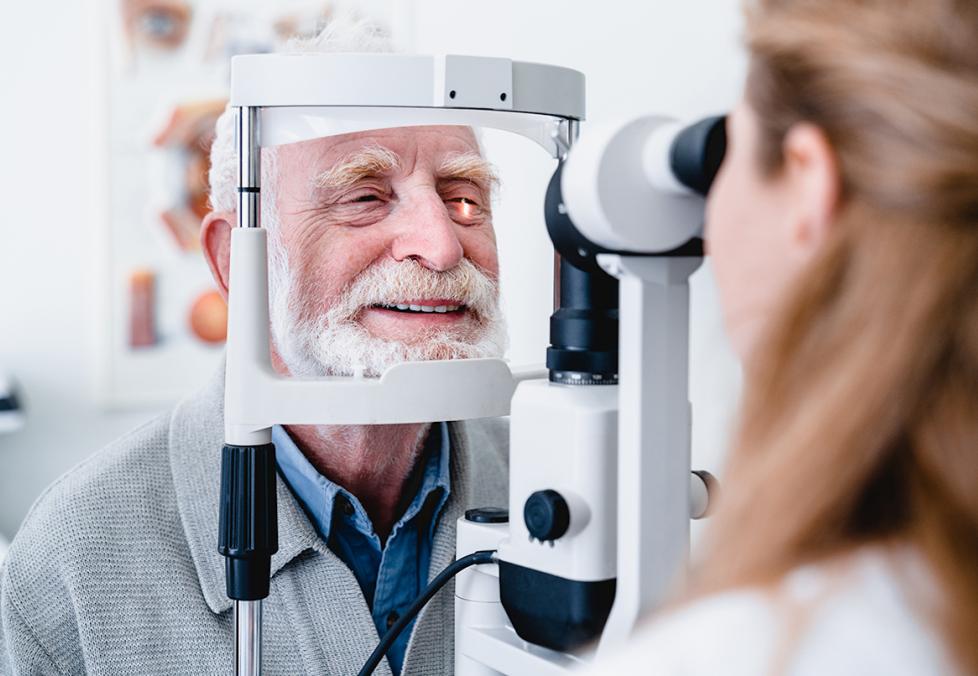
Book an eye exam, take advantage of our popular two-pair offers, restock your contact lenses — or all three!
Everything you need to know to take care of your eyes — for life.
You know that high blood pressure is a problem for your heart, but did you know that the condition is a threat to your vision too? Here’s why.

Your optometrist’s office might seem like the last place you’d expect to chat about blood pressure, but high blood pressure (also known as hypertension, HBP, or HTN) is more than a heart problem — it’s a whole-body problem. And your eye doctor is in a unique position to spot and help monitor this often asymptomatic, or “silent,” disease.
That’s because in an eye exam, your doctor looks directly at your blood vessels — something that’s not possible anywhere else in the body. The tiny vessels in your retinas are susceptible to damage from high pressure, so they can serve as an early indicator of high blood pressure.
“Eye doctors can actually see the blood vessels in the eyes and sometimes aid in the diagnosis of high blood pressure, especially in patients who haven’t had a routine physical in some time,” says Crystal Tong, O.D., F.A.A.O., an optometrist with Redwood Sage, PC, located within America’s Best Contacts & Eyeglasses in Eastvale, California.
What’s more, because of this special “easy access” view of your blood vessels, if you have been diagnosed with high blood pressure, your eye doctor becomes an important member of your health care team. When you stay up to date with your regular eye exams, your eye doctor can help you keep tabs on your blood pressure. They can also alert you to warning signs of possible vision problems due to high blood pressure. And they can share important lifestyle advice that can help protect your eyesight and help you keep your blood pressure in a healthy range.
Eye exams are an essential part of your health care routine. Book an appointment with your America’s Best optometrist today!
Very simply put, high blood pressure is when the force (pressure) of the blood pumping through your body is too strong (high). That force puts unnecessary, often damaging, wear and tear on your heart and the rest of your circulatory system.
Here’s a little deeper dive into the mechanics: When your heart beats, it’s pushing blood through your circulatory system. That’s the network of arteries, veins, and smaller capillaries that deliver blood to the rest of your body.
If you’ve had your blood pressure checked with a cuff (or if you’ve seen even a single medical TV show), you’ve heard blood pressure readings referred to as “110 over 60” or “130 over 80” or something similar. That first number (systolic pressure) is a measure of how strongly the blood is pumping into the arteries when your heart beats. A normal reading is generally considered to be less than 120. The second number (diastolic pressure) measures the pressure when your heart rests between beats. It should generally be lower than 80. (More about ideal blood pressure numbers later.)
Nearly half of American adults have high blood pressure, according to the American Heart Association (AHA). Unfortunately, the symptoms can be hard to spot. That means a lot of people don’t even know they have an issue until they suffer a heart attack or stroke or develop vascular dementia, notes the AHA.
High blood pressure has many possible causes. Some are things you can’t change:
Your age and sex. The older you are, the more likely you are to have high blood pressure, because your blood vessels are becoming less elastic. Men are more likely than women to have hypertension — up until age 65. At 65 and older, women are more likely to have high blood pressure.
Your race. African Americans tend to develop high blood pressure more often than people of any other racial background in the United States, the CDC says. White people are the next most likely group to have high blood pressure, followed by people of Asian descent and then Hispanic people.
A family history. If your parents or other close relatives have high blood pressure, there’s a greater chance you’ll develop it too.
Preexisting medical conditions. Diabetes, sleep apnea, some heart defects, certain kinds of kidney disorders, and pregnancy can all make you more prone to high blood pressure.
Then there are the factors you can do something about. These include:
All that excess pressure on the walls of your arteries can damage them, as well as other organs, such as your heart and your brain. Over time, untreated or uncontrolled high blood pressure can lead to a variety of eye problems too.
This is where that direct look at the blood vessels in your retinas during your annual eye exam truly comes into play. Eyes have veins and arteries inside of them that branch into smaller vessels, explains Dr. Tong. When the force of the blood flowing throughout your body is consistently too high, it can damage the tiny vessels in your eyes. This condition is called retinopathy, and it can have serious consequences for your vision.
In addition to retinopathy, the American Heart Association points out common eye conditions that can result from undetected or poorly managed high blood pressure, including:
Nerve damage (optic neuropathy) that can cause vision loss
A buildup of fluid within the retina that can distort or weaken vision
Eye strokes, which are usually painless and appear with little warning. They are most often detected when someone notices a loss of vision in one eye when they wake up in the morning, according to information from Penn Medicine. Or they might notice a shadow in the upper or lower half of their visual field. If you notice this symptom, call your eye doctor right away to have it checked out.
Blood spots in the whites of your eyes (subconjunctival hemorrhage): This one is unsightly but typically has no serious consequences. It occurs when tiny blood vessels break and cover the white part of your eyes.
“Blood spots are often painless, and you may not even realize it has happened until you look in the mirror or someone mentions it to you,” Dr. Tong says. But this symptom still warrants a call to your eye doctor for a proper diagnosis.
The tiny blood spots usually clear up within two weeks, but any one of the other conditions mentioned above can cause blurred or distorted vision or even permanent loss of sight.
Most important: You should get to your optometrist’s office ASAP if you notice recurring headaches with changes in vision, says Dr. Tong. Don’t wait for your regular eye exam to bring this symptom to the attention of your eye doctor.

Book an eye exam, take advantage of our popular two-pair offers, restock your contact lenses — or all three!
“If you’ve been diagnosed with high blood pressure, you should get an eye exam at least once a year,” Dr. Tong says. “You may need to visit your eye doctor more regularly if there are any other underlying health conditions or concerns.”
During these checkups, your doctor will look for telltale signs that high blood pressure is doing damage, including:
Depending on what is found during the exam, your doctor may recommend additional testing for a suspected eye problem. Or they may refer you to your primary physician for blood pressure screenings.
They’ll also discuss ways to help lower your blood pressure and keep it at a healthy level. Dr. Tong stresses that getting good results from your eye exam doesn’t mean that you don’t have any high blood pressure–related health issues. Your optometrist can diagnose some conditions, she says, but your primary care provider can do a more thorough screening and recommend medications to lower your blood pressure, if necessary.
If you’ve been diagnosed with high blood pressure — even if you feel fine and are having no vision problems — follow your primary care doctor’s treatment plan. That typically involves three prongs: (1) monitoring your blood pressure, (2) developing healthy lifestyle habits, and (3) taking medication.
1. Monitor. Knowledge is power, and you do have the power to manage your high blood pressure — first by knowing how high it is. Your doctor will check it at your visits, of course, but regularly monitoring it at home gives you (and your doctor) more information and can keep you motivated to make changes to bring those high numbers down.
The American Heart Association (heart.org) has a handy chart to help you interpret what the numbers mean, but here are the basics:
2. Adjust your lifestyle. Many times, doctors will suggest making key lifestyle changes to try to lower and control blood pressure without medications. The changes will probably come as no surprise. You will want to do some or all of the following — keeping your doctor in the loop, of course.
Keep an eye on the scale. According to the AHA, if you’re overweight, even a small amount of weight loss can help.
Move more. One tried-and-true way to help control high blood pressure: Get more exercise. The AHA’s recommendation is to get 30 minutes of physical activity per day, at least five days per week. And it doesn’t have to be 30 minutes all at once — you can break it up into manageable segments that work with your schedule.
Clean up your diet. Eating well aids weight loss and can positively impact a lot of other aspects of your health as well. Plan your meals to include plenty of fruits and vegetables, whole grains, and lean proteins like chicken, fish, and beans.
At the same time, limit saturated fat, sugar, and sodium. Studies have shown that eating more salt is associated with having higher blood pressure. The AHA suggests that no one eat more than 2,300 milligrams of sodium per day, and if you have high blood pressure, your upper limit should be 1,500 milligrams per day.
Find healthy ways to unwind. Elevated stress hormones raise your blood pressure temporarily; it goes back down when the stress goes away. So it makes sense that if you’re under the kind of stress that pretty much never eases up, you’re going to have chronic high blood pressure.
There are countless ways to work on your stress level. Many people incorporate yoga, meditation, deep breathing, and other mindfulness practices into their daily routine. It’s also smart to prioritize sleep and spending time with friends, family members, and pets. Of course, you’ll also want to take steps to reduce and minimize the amount of stress itself, in addition to your response to it.
Cut out tobacco use, and reduce your alcohol intake. Your health care team can recommend programs to help you quit.
3. Medication. If lifestyle changes alone aren’t enough to bring your blood pressure down, your primary care doctor may add the third prong of treatment: medication. There are several types, and you’ll need to talk to your doctor to determine which one will work best for you.